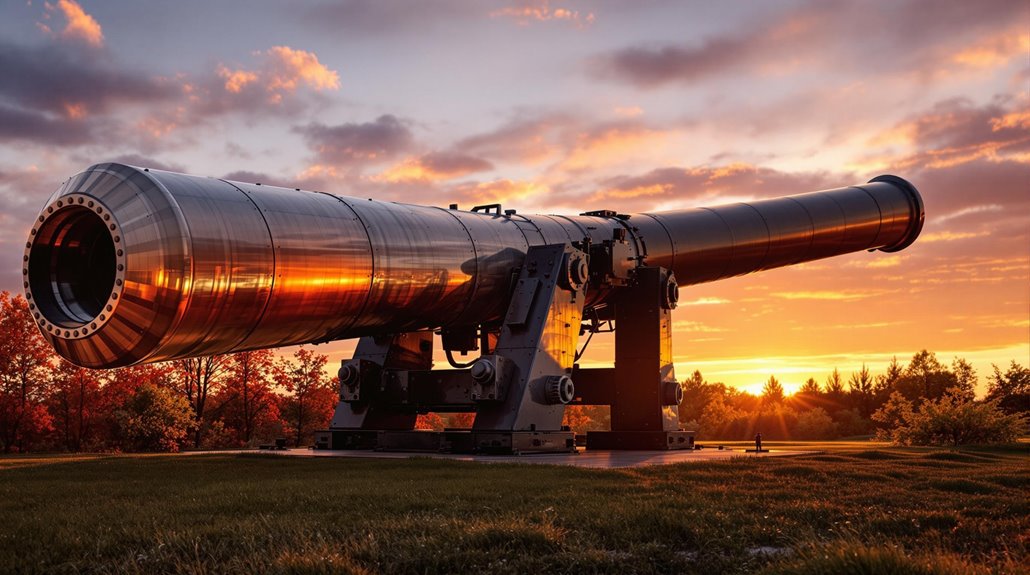Canada’s Giant Gun to Orbit: A Bold Idea
While NASA was focusing on traditional rockets, Canada was dreaming of shooting satellites into space with a massive gun. You've probably launched model rockets or seen footage of space shuttles, but you've never encountered anything quite like Project HARP. This 1960s endeavor wasn't just another space program—it was a radical reimagining of how we could reach the stars. What drove these scientists to point a 16-inch naval gun barrel toward the heavens, and what lessons can we learn from their audacious vision?
The Visionary Behind the Space Gun

A brilliant Canadian engineer revolutionized the concept of space launches through his unconventional vision of using giant guns to reach orbit. Born in North Bay, Ontario in 1928, this visionary genius demonstrated extraordinary talent from an early age, entering the University of Toronto at just 16 and becoming McGill University's youngest professor at 33.
You'll find his innovative thinking emerged during his work at CARDE, where he pioneered new methods for studying missile aerodynamics. His ingenuity led him to develop a 1,000-yard range for testing projectile velocities.
After Sputnik 1's launch, this innovative thinker conceived the idea of using modified artillery to reach space. His expertise in ballistics and aerodynamics led him to establish the High Altitude Research Project (HARP) in 1961, collaborating with the U.S. Army and McGill University to transform his ambitious space gun concept into reality. The project achieved remarkable success when it launched a Martlet projectile to 180 kilometers in 1966.
Project HARP's Ambitious Goals
While traditional rocket launches dominated the space race, Project HARP emerged in the 1960s with revolutionary aspirations to slash the cost of reaching orbit.
You'll find that its ambitious goals stretched far beyond mere space exploration, as researchers aimed to reveal the mysteries of Earth's upper atmosphere and perfect the art of high-speed projectile delivery.
The project's pursuit of cost efficiency drove its innovative approach: using modified naval guns to propel finned Martlet missiles up to 180 kilometers high. Similar to how cross-sector collaboration drives innovation in healthcare policy today, HARP united military and scientific expertise to achieve its goals.
Led by brilliant Canadian engineer Gerald Bull's team, the project demonstrated remarkable technological prowess in converting naval artillery for space research.
You could see HARP's commitment to scientific advancement through its diverse research objectives, from studying re-entry vehicle dynamics to mapping atmospheric wind patterns.
Through over 100 successful launches, the project demonstrated that you didn't need conventional rockets to push the boundaries of space technology.
Engineering Marvel: The Giant Gun Design
Through ingenious engineering, Project HARP's massive space gun stood as a symbol to innovative thinking in space exploration.
The project's ambitious goals originated when Dr. Gerald Bull proposed using artillery for high-altitude research after being inspired by Sputnik's launch.
You'll find that overcoming key design challenges required remarkable engineering innovations, resulting in a 16-inch naval gun barrel extended to 36 meters and weighing 125 tons.
Using expertise gained from early collaborations, Bull developed the gun to fire weather probes for atmospheric research.
The gun's sophisticated design included:
- Hardened electronics that could withstand extreme acceleration forces
- Advanced telemetry systems integrated into the projectile head
- Aluminum fins engineered for maximum stability during flight
- Specialized recoil mechanisms to handle the massive powder charges
The "Martlet" projectiles showcased equally impressive engineering, featuring a cylindrical design with wooden sabots and various payload options.
At 80-degree firing angles and reaching muzzle velocities of 7,100 feet per second, this marvel demonstrated how conventional artillery could be transformed for space applications.
Breaking Records in the Sky
Since launching its first satellite in 1962, Canada has consistently pushed the boundaries of space exploration and achievement.
You'll find remarkable satellite advancements throughout the nation's space history, from Alouette I's decade-long mission to today's cutting-edge RADARSAT Constellation. The nation's commitment to space exploration was strengthened through its role as a founding member of Intelsat in 1964.
2023 marked an exceptional year for record launches, with Canada sending 23 satellites into orbit – double the combined total from the previous two years. The Earth observation capabilities were significantly enhanced through these new satellite deployments.
You're witnessing an unprecedented era of space activity, as Canadian universities and companies drive innovation forward.
The University of Toronto Aerospace Team shattered the national amateur rocketry altitude record, while the AlbertaSat team continues developing advanced satellites for wildfire monitoring.
These achievements, coupled with MDA's historic Telesat contract, demonstrate Canada's growing influence in the commercial space sector.
From Scientific Dreams to Military Applications

As peaceful scientific ambitions merged with military interests, Project HARP emerged in 1961 as a groundbreaking joint venture between Canada and the United States.
You'll find that while the project began as a scientific collaboration between McGill University and the U.S. Army, it quickly evolved to serve both research and defense purposes.
The project's innovative nature was demonstrated through its 16.4 inch smooth-bore gun that achieved unprecedented results in atmospheric testing.
Canadian defense research continues this innovative legacy through the development of lightweight telescoped ammunition for modern military applications.
The military technology aspects of HARP became evident through:
- Development of advanced telescoped ammunition
- Testing of long-range artillery capabilities
- Creation of dual-use technologies for space and defense
- Implementation of sophisticated tracking and telemetry systems
The U.S. Army's involvement wasn't just about space exploration – they saw HARP as their chance to compete with Air Force and NASA programs while advancing artillery science.
 Martlet 2 vehicle setting new altitude records and earning increased US Army funding.
Martlet 2 vehicle setting new altitude records and earning increased US Army funding.
The massive gun, constructed using two battleship barrels, remains a testament to the project's ambitious engineering scale.
You'll find that political opposition and funding cuts eventually forced the project's closure, as Canada viewed it as primarily American-driven while competing with their own Black Brant rocket program.
The project's legacy lived on through its pioneering achievements in space research, but took a dark turn when Gerald Bull, its visionary leader, was assassinated in 1990.
After facing intelligence threats and break-ins at his home, Bull's death was linked to his controversial work on Iraq's Project Babylon.
Despite its controversial end, HARP's scientific impact continues to influence modern space technology, inspiring later gun-launch projects and contributing valuable data to upper atmosphere research.










